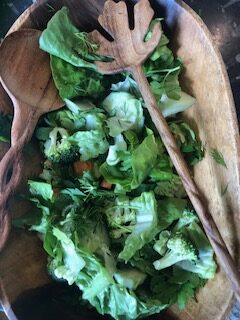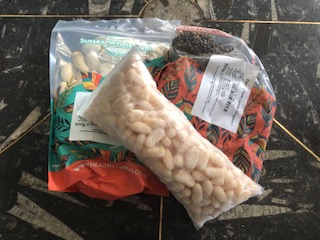Greetings all! I’m finally back to full strength and enjoying the explosion of colour that marks the appearance of summer. The season is always a joy: filled with floral extravagance and the freshest, tenderest produce.
My own attempts at growing have been somewhat stymied by the voracious appetites of our garden gastropods, but I have some hope for my fruit trees and bushes and perhaps my squash. We’ll see.
Luckily for us, the supermarkets and grocers are fully stocked and we can choose any number of delicacies. Taking advantage of this abundance, Mariia and I (and now my husband too, who takes a lunchbox) have been enjoying the most delicious lunches composed of the season’s offerings.

Image: Karen Costello-McFeat
Gut health
It is also rather rewarding to discover that we have been doing exactly what is necessary for our guts (and our immune systems) to thrive. The Overcoming Multiple Sclerosis programme has been advocating this for years, and it seems that the world has caught on.
Eating lots of raw and unprocessed foods, in a rainbow of colours and varieties, ensures that our guts work at their best. One of my favourite chefs, Hugh Fearnley-Whittingstall, has just written a cookery book on How to Eat 30 Plants a Week based in part on the work of Tim Spector (who also has a book and co-founded Zoe). I’ve referenced them so that you can find out a bit more about the science (Tim Spector) and additional ideas (Hugh). But if you want an easy entry to the topic – read on!
Through feeding our bodies with fresh, healthy foods, we can help diminish the chances of succumbing to any number of nasty health conditions: the auto-immune ones, which include cancer and MS; heart disease and all the horrid embarrassing ones like IBS.
I credit the OMS diet – plant based with a wide variety of foods – as an essential part of my keeping my MS stable. It also ensures that I look well – healthy skin, nails, and hair are all reflections of a healthy diet.
Buddha bowls for beginners
When I first embarked on making Buddha bowls regularly, I began with a salad and then went from there. A delicious, green salad is the perfect base for your meal and, when made in bulk, lasts at least a few days in the fridge.

My family has always loved an interesting salad and there are no holds barred when it comes to ingredients. These are things that might get thrown in: salad leaves, pea shoots, cucumber, broccoli, avocado, apples, mint, marjoram, dill, parsley, chard, spinach, rosemary, onions and carrots for a bit of colour. Whatever you have in the fridge, or enjoy, should form the base of your bowl. I use loads of herbs, as they are superfoods and grow in my garden – but they are equally easy to grow on the windowsill.
Grains
I’m not sure that I could survive with just a green salad. Something a little more substantial is called for. My go-to choice would be couscous, cracked bulger wheat and quinoa.

All of these can be cooked with vegetable stock and/or dressed with oil and vinegar or lemon. For tabbouleh, add chopped fresh mint, spring onions and dried fruits.
Though I invariably make a huge amount, it never seems to last long. Luckily, they only take minutes to cook. By using the residual heat method (add liquid, bring to boil, cover and leave with lid on and heat source off) it could not be easier. Any left-overs will improve in the fridge where they take on the flavour of the dressings.
Bean there, done that
Another way to ensure that lunch will keep you going is to add beans and lentils to the bowl. I especially love giant butter beans, chickpeas and beluga lentils.
Many of us are put off these, as the ones we get in a tin are seldom very toothsome. For chickpeas, I always buy them in jars and the beans and lentils, I cook in bulk from dried.

Again, do not despair in anticipating lots of preparation. Beans need soaking overnight in a large bowl (they expand exponentially). Lentils just need rinsing. Despite what many of my cookery books advise, a pressure cooker or hours standing over the stove is not necessary. Most beans and lentils will cook fine if you add the required water, bring to the boil and then leave off the heat with the lid on until the water has cooled. If your beans need an extra blast to make them soft, simply repeat.
I tend to cook my beans and lentils 500g at a time (dried) and when everything is cooked and cooled, put them into little recycled bags and freeze. (Aim for about a tin drained weight and they will be perfect for all your recipes.) With salad dressings, mayonnaise or plain, they add a delicious bit of protein to your meal.
Extras!
My family are total foodies for whom the expression, ‘If less is more, imagine how much more would be,’ is especially apt. Our bowls may start with the basics of leaves, beans and grains, but they soon turn into a cornucopia of deliciousness sourced from whatever is in the fridge or on our shelves.
As these are all premade or long life products, it allows us to vary our bowls without much extra effort. Hearty additions include houmous, olives , pickles, nuts, fruit and left-overs.


Is there a little dollop of houmous in the fridge? Drop it in. One lonesome veggie sausage from last night’s dinner? Slice and add. Many fruits, dried or fresh can add a bit of zing to your bowl. Those non-vegans among us can turn to the trusty staples of tuna and cheese.
Not just for summer
Though these salad days are the perfect time to get into the Buddha bowl vibe, they are equally good during the cooler months. Choose leaves that are in season where possible or create scrumptious slaws with cabbage, carrot and apples. The options are endless.
I hope that you will take the opportunity to try this wonderful food concept and enjoy nourishment and enlightenment in one.
My husband and I are off for a cultural vacation in Vienna next week. I wish you sunny days and look forward to writing to you again when we get back. x
